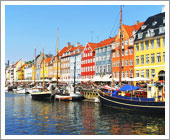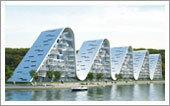Denmark Health Insurance
 |
|

Perched on a peninsula in Northern Europe, bordering the Baltic and
North Seas, the diverse country of Denmark and its small chain
of islands is a showcase for natural beauty. Characteristic
elements of the landscape include rolling meadows dotted with
windmills, historical towns, cobblestone streets and medieval
churches. Some of Denmark’s long and fascinating history is
captured in Viking ruins and impressive Renaissance castles.
The country is lined with splendid strips of sand and scenic
cliffs. For Denmark’s estimated 5.5 million courteous
inhabitants, (CIA, 2012) proximity to the seashore is no more
than an hour’s drive away from anywhere in the country.
Approximately 25 percent of Denmark’s residents live in the
capital city of Copenhagen, which is known for its
waterfront statue of the Little Mermaid, and its modernity and
good design. The latter of which is evident in its faultless
transportation system. A Claim to the highest per
person GDP in all of the European Union is
supported by the country’s hydrocarbon-rich economy and
state-of-the-art industry involving world-leading companies
in maritime shipping, renewable energy and pharmaceuticals.
Linguistic unity in Denmark is strong; the official
standard of Danish is based on the capital Copenhagen’s
dialect. There is little to no barrier in communication for
English-speaking visitors, as English is the predominant
second language and spoken by the majority. Significant Danish
dialects however can be found beyond the boundaries of the
Kingdom, on the Faroe Islands and in Greenland.
Denmark Health Care and Insurance
Danes enjoy a standard of living amongst the highest in the world,
the government welfare measures are extensive, and
distribution of income equitable. The Ministry of the Interior
and Health has overall responsibility for the health sector in
Denmark, formulating policy and issuing guidelines which the
local health authorities in each of the country’s 14 counties
are charged with implementing. High quality care is widely
available in Denmark, hospitals are well equipped and health
clinics are evenly dispersed and accessible. Citizens and
permanent residents, once registered, are eligible to receive
free hospitalization and medical treatment under the National
Health Service. The health service administers Denmark’s
health insurance system, which provides cover for
consultations with doctors and specialists as well as
subsidizes prescription drug fees, treatment by chiropractors,
podiatrists, physiotherapists and psychologists and some
dentistry services. Alternative therapies such as acupuncture
are also subsidized.
Two categories of Denmark health insurance are available and are
simply known in the country as Insurance Group 1 and 2. The
majority of the population opts for cover under Insurance
Group 1, which requires patients to nominate one doctor as the
family physician from a list of practitioners operating within
the patient’s residential area. All consultations with the
nominated doctor are covered by the health insurance system.
For those under this insurance category, any specialist
appointments require a referral from the family GP. Residents
who opt to join Insurance Group 2 pay a higher insurance
premium. However, they can use any GP at any medical
facility, and a referral is not required for specialist
appointments. Newly arrived long-term foreign residents from
nominated countries can qualify for immediate cover under the
scheme, although private insurance will be required for some,
due to a wait period of at least 6 weeks after registering
with Danish authorities before health service entitlements are
allowed.
As medical treatment and hospital care covered under the National
Health Service often requires a referral from a GP, long
waiting periods ensue, prompting patients to seek medical care
privately and pay out-of-pocket. A number of private hospitals
and clinics operate within the health sector; however
the costs associated with such care are considerable. Therefore, additional private health
insurance is used by residents as a top-up to guarantee use of
private facilities and to pay for services not covered under
the national scheme, which includes some dentistry services
and out-of-pocket payments for medications.
Emergency departments in the main hospitals operate 24 hours a day, 7
days a week, accepting patients if treatment is required for
an injury or illness which has occurred within the preceding
24 hours. Depending on the type of illness or injury, some
emergency departments may refuse patients unless they have a
doctor’s referral. Emergency treatment is free, although
follow-up care is at the patient’s own expense.
Visitors do not qualify for treatment under the National
Health Service, except in the event of an emergency, but even
then, if the medical facility determines the emergency is a
result of a pre-existing condition visitors are expected to
pay for all treatment. It is therefore prudent for visitors to
arrange international medical insurance to ensure the high
cost of treatment in non-emergency and some emergency
situations, does not become burdensome. Ambulatory services
can be reached in the country and on the Faroe Islands, by
dialing 112.
Reflective perhaps of a well-established and well-organised health
system are indicators such as infant mortality and life
expectancy, which are used to point to living conditions and
standards in countries. Infant mortality is reported at 4.19
deaths for every 1,000 live births in Denmark, (CIA, 2012) a
statistic among the best in the world. Estimated life
expectancy currently stands at 76 years for men and 81 years
for women, having steadily increased over the decades,
surpassing the United States and only just
shy of the likes of Belgium, Austria and the United Kingdom.
 |
|
Denmark's medical insurance industry is a fast paced ever evolving market however our staff are experts and at your disposal. |
Expatriates and Travelers in Denmark
|
Denmark Travel Insurance Concerns
Denmark’s Security and Intelligence Service instructed police
districts across the country to increase their
state-of-readiness in late 2010, due to the threat of
terrorism, assessing the threat-level as ‘significant’. A
number of arrests and convictions related to terrorism
offences have been made in Denmark and the country reportedly
remains a target, due in part for the printing of cartoons of
the Islamic Prophet Mohammed in 2005. This has
prompted advisories from other developed nations to recommend
individuals remain security conscious at all times, be
vigilant in public places, and stay informed of potential
safety risks by monitoring local information sources.
Conversely, Denmark has a low rate of serious crime, other than
localized disturbances and confrontations with authorities,
which have occurred in recent times. These are generally
gang-related. However, caution should be exercised, in and
around Norrebro especially. Protests and demonstrations surge
periodically in Denmark and visitors are advised to avoid such
large public gatherings. Organised petty-crime such as bag
snatching and pickpocketing has increased and is particularly
problematic during summer, the peak tourist season. Busy
public areas such as the central train station, airports,
hotel lobbies, restaurants, crowded transportation,
and tourist spots are areas favoured by petty
criminals. In the event of injury as a result of crime,
international medical insurance cover is recommended to avoid
the high cost of medical treatment in the country.
Despite outbreaks of bird flu being confirmed in wild birds in
Denmark, the risk of contracting the disease is low.
Nevertheless, advisories do suggest avoiding close contact
with live birds and taking precautions such as ensuring all
egg and poultry dishes are well cooked. Due to a recent
increase in measles cases, those not previously immunized are
recommended to have the pre-exposure
vaccination before travel, along with any routine childhood
vaccinations which are not up-to-date. Denmark’s health
authorities report Legionnaires disease more frequently than
any other European country. The reason for this is
still under debate, it has not been confirmed as to whether
there is an increased prevalence of the disease or increased
awareness of it amongst doctors, and therefore
more frequent diagnoses. A small risk of contracting
tick-borne encephalitis exists in forested or rural areas
during summer, therefore insect protection is advised.
Denmark Expat Health Insurance
Public health services in Denmark are extensive, efficient and of
high quality. However access is limited to registered
long-term residents and citizens, who depending on the type of
treatment required, will be put on a waiting list. Private
insurance is relied upon by a significant portion of the
population to provide cover for services not included in the
state health insurance plan and to bypass queues for
treatment. Visitors and newly arrived residents are restricted
to using private medical facilities unless in a
life-threatening emergency, therefore these groups are exposed
to considerably more costly services, hence the need for
private insurance cover. International Medical Insurance has
policies which deliver a comprehensive range of benefits,
including medical evacuation and repatriation, private
hospital doctors’ fees and costs associated with
maternity services. To ensure the cost of medical treatment in
Denmark does not result in financial burden, contact an
International Medical Insurance consultant today for a free
quotation.
|

